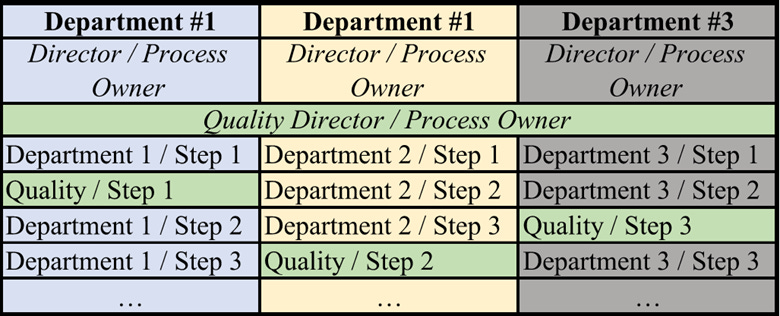Integrate Quality and Strategy
A business case is a strategic value proposition.
Starter Questions
Is quality integrated into your daily business tasks?
How does your company create value?
How can your business case help advance the business objectives of other stakeholder departments?
Isolated Quality
Quality as a process, though required by our contracts and insurance, isolates quality from business operations. The table below illustrates the organization as a set of processes, where each department is lead by the department director, leading the process for that department. The director for Department #1 is the process owner for how Department #1 executes their work.
Though not always intentional, departments and their processes become isolated. If a quality program exists, it becomes its own silo as the quality process owner is seen as the subject matter expert by the other department directors. Quality knowledge and responsibility organically flow through the quality leader to the rest of the organization rather than through the company leadership. This cements quality as a process.
Note: Quality “as a process” is not inaccurate as a function, but as a perspective of the company, it is more difficult to integrate when this “process” viewpoint exists. Quality “as a result” forces each department process to work with one another. The resulting friction creates an environment for improvement as redundant tasks reveal themselves.
Integrating quality into the company operations requires an understanding of the overall company strategy and the business objectives of each department. When the quality program advances the business objectives of each department – and thus the overall company plan – quality is seen as a necessary element to success, rather than extra administrative work “required by corporate”.
The Value Proposition
A business case is a strategic value proposition. In 7 Powers: The Foundation of Business Strategy, Hamilton Helmer notes: “The sole objective of a strategy is to increase the potential value of the business” (43). Your business case must answer: How will investing in quality increase the value of your business?
Integrating Quality with Business Strategy
The above showcases a means of integrating quality within the overall company strategy.
Identify your company’s core Focus Areas. These will come from the corporate business plan. Example objectives include entering a new geographic market, improving employee satisfaction, achieving x% YoY growth, or vertical integration of the supply chain. The quality program will create value for the organization by helping the company achieve these objectives.
Identify stakeholder Departments that would be most impacted by an investment in quality. Each department (or business unit) will have their own business objectives that should also advance the company’s Focus Areas.
Interview the Department or business unit leaders who lead those department functions. They are the Process Owners that determine how the department-level processes operate. Ask them how an investment in quality would help advance their own departmental business objectives. Their decisions are informed by Internal and External Data.
Internal Data include profit margins, the cost per FTE (Full-Time Employee), quality and safety incidents, schedule delays and their root causes, warranty costs.
External Data include market information, what your customers and partners are saying about you and your products, regional labor force availability, supply chain limitations, and other economics factors.
Define Quality at your organization. Department leaders and Process Owners must understand how quality will impact their part of the business, and this is only achieved by having a clear, tactical definition for quality. As you seek feedback across the company (Parts 3 and 4 of the framework, forthcoming), asking “What does quality mean to you?” will help refine your quality meaning. The meaning needs translate from leadership to those executing the work, resonating throughout the entire organization.
Establish your Quality Objectives. The Quality Objectives are the actions of your business case and the solutions you develop while analyzing stakeholder feedback in Part 4 (forthcoming). They also include and address the concerns shared by your executives in Part 2 (forthcoming).
Identify what success looks like for each of your Quality Objectives and create Key Results for each. These are the metrics by which you will measure success and the essence of reporting after the business case is approved. This effort is detailed in Part 6 (forthcoming) of the framework.
Note: The measurement strategy here follows Objectives and Key Results. You’ll need to pick a measurement strategy your organization is familiar with.
This alignment of your Quality Objectives with Department and company Focus Areas is the key to integrating quality into your daily operations. By helping other departments achieve their goals, these Process Owners will be more inclined to support your business case.




